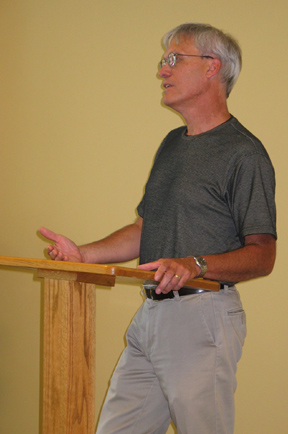Eleven of the total 126 workers aboard the rig at the time died in the blast or the fire that followed. The rig was drilling, but not in production. Good said the workers on the rig were employees of BP, Transocean, Halliburton and other companies and agencies. Transocean is the world's largest offshore drilling company, headquartered in Switzerland. The largest of its world-wide offices is in Houston. Halliburton is one of the world’s largest oilfield services corporations with operations in more than 70 countries.
 Good noted that there were several levels of safety measures on the oil rig. “The one they were counting on was on the ocean floor,” he said. “There are many theories on what happened and why. But most everyone agrees that corners were cut. It appears to be a perfect storm of events. There may have been some carelessness.
Good noted that there were several levels of safety measures on the oil rig. “The one they were counting on was on the ocean floor,” he said. “There are many theories on what happened and why. But most everyone agrees that corners were cut. It appears to be a perfect storm of events. There may have been some carelessness.
“Like the rest of us, when you do something over and over, you can become complacent,” he continued. “It’s something we worry about at Good Oil, after 70 years of handling gas without a serious accident.”
After the incident, Good said BP was telling its retailers and the rest of the country what happened and what to expect as efforts continued to cap the gushing oil well and contain the damage, “but their reports weren’t lining up with what we were watching on the news. We called BP and told them so.”
So BP invited Good and some other retailers to several work sites around the Gulf shoreline. Good was sent to Zone 5 in Pascagoula, MS to a “unified command center.” There he observed and met with some members of a panel of state and federal agencies, especially environmental and parks officials, plus Transocean, BP, Halliburton representatives and others working on the environmental and economic impact of the oil spill.
Good said the EPA explained how different parts of the gulf have been affected differently. He had an opportunity to observe the tracking of the spill. “The science was amazing to me,” he said.
But those observing with Good were especially moved by the story of a young Coast Guard man who had been working on clean-up efforts. “He was very proud of what they had accomplished,” Good said.
He noted that many comparisons have been made with the BP and Exxon Valdez spills. (In March 1989, the tanker Exxon Valdez, en route from Valdez, Alaska to Los Angeles, ran aground on Bligh Reef in Prince William Sound, Alaska. The vessel was traveling outside normal shipping lanes in an attempt to avoid ice. Within six hours of the grounding, the Exxon Valdez spilled approximately 10.9 million gallons of its 53 million gallon cargo of Prudhoe Bay crude oil.)
There are some “big differences,” Good explained. The Valdez was carrying “sour” crude which is a heavier, more tarry substance. The Gulf oil spill is “white or sweet” crude, a lighter substance. The Valdez hit ground and dumped, while the BP spill occurred 55 miles off shore, allowing time to treat and contain some of the spill.
Good reported that the residents of the area have a “love, hate” relationship with BP. “The fishing industry is important to them, but the oil industry is more so. They still hate FEMA (the federal agency partly accused of bungling the response to Hurricane Katrina) the most.”
“No one should give BP a pass on this,” Good emphasized. “At the end of the day, we, as BP associates, and the rest of us as citizens want two things from BP, ‘make it work’ (a reference to capping the well) and ‘make it right,’" (a reference to restoring the damage to the environment and local economy).
“Who knows what the long term effect will be? That’s what we all want to know,” he said. “Any damage is too much. The effects will be played out in the next decade.”
He said he doesn’t believe the national media has mis-reported the event as a whole, but there have, perhaps, been some cases of selective reporting. For instance, in the early days there were stories that BP had underestimated the amount of oil gushing from the damaged well.
“That information wasn’t coming from BP,” Good said. “The Coast Guard was making those reports. They were doing their best, but the spill is miles down. It’s dark, and the water is murky.”
Also, he pointed out that only one county in Florida has seen tar balls on the beaches. “Yet the tourist industry there has been decimated because we have been led to believe there is oil on the beaches.”
Ironically, BP’s safety record had been good the past seven years, following two accidents in Texas and Alaska, according to Good. “BP was cracking down on safety, and we say this,” he reported. On the other hand, he added, Transocean’s record was not as good. “But until now, no one knew who they were.”
Good believes BP thought this disaster “could never happen. But their response has been very good in this uncharted territory.” He also suspects that part of the problem is the companies involved “got too cozy with government regulatory agencies. I think that will change real quick.”
After his talk, Good was asked if he thinks the incident will affect gas prices.
“I don’t think so,” he responded. “The rig was not yet in production. I believe the economy will have a bigger effect. Right now our country has more gas in storage than at any time in history. Usage is down. The futures markets and hedge prices will have more effect.”
He was also asked about the reasons for Good’s Medaryville station switching from the BP to Marathon brand. He responded that this move at Medaryville, and also at their Reynolds station, was in the planning process before the April disaster. “Working with a big oil company has its pluses and minuses,” he observed.
He concluded that Good Oil has been fortunate with its customers, who have proved to be “more inclined to thinking than reacting.” But in conference calls with other BP retailers, he reports that many have been hurt economically, and some have experienced vandalism.







